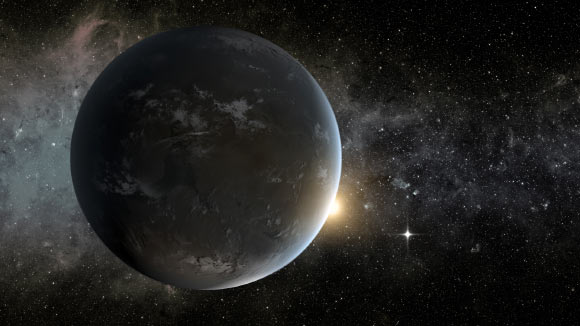K-type dwarf stars are dimmer than the Sun but brighter than the faintest stars. These stars live a very long time — 17 billion to 70 billion years, compared to 10 billion years for the Sun — giving plenty of time for life to evolve. Also, they have less extreme activity in their youth than M-type stars (red dwarfs), the most common star type in our Milky Way Galaxy.

An artist’s concept of a planet orbiting in the habitable zone of a K-type star. Image credit: NASA Ames / JPL-Caltech / Tim Pyle.
“I like to think that K stars are in a ‘sweet spot’ between Sun-analog stars and M-type stars,” said Dr. Giada Arney, a research space scientist at NASA’s Goddard Space Flight Center and lead author of a paper published in the Astrophysical Journal Letters.
Dr. Arney wanted to find out what biosignatures might look like on a hypothetical planet orbiting a K-type star.
“Scientists consider the simultaneous presence of oxygen and methane in a planet’s atmosphere to be a strong biosignature because these gases like to react with each other, destroying each other,” she said.
“So, if you see them present in an atmosphere together, that implies something is producing them both quickly, quite possibly life.”
“However, because exoplanets are so remote, there needs to be significant amounts of oxygen and methane in an exoplanet’s atmosphere for it to be seen by observatories at Earth.”
Dr. Arney found that the oxygen-methane biosignature is likely to be stronger around a K-type star than a Sun-like star.
She used a computer model that simulates the chemistry and temperature of a planetary atmosphere, and how that atmosphere responds to different host stars. These synthetic atmospheres were then run through a model that simulates the planet’s spectrum to show what it might look like to future telescopes.
“When you put the planet around a K star, the oxygen does not destroy the methane as rapidly, so more of it can build up in the atmosphere. This is because the K star’s ultraviolet light does not generate highly reactive oxygen gases that destroy methane as readily as a Sun-like star,” Dr. Arney said.
This stronger oxygen-methane signal has also been predicted for planets around M-type stars, but their high activity levels might make M stars unable to host habitable worlds. K-type stars can offer the advantage of a higher probability of simultaneous oxygen-methane detection compared to Sun-like stars without the disadvantages that come along with an M star host.
Additionally, exoplanets around K-type stars will be easier to see than those around Sun-like stars simply because K stars are dimmer.
“The Sun is 10 billion times brighter than an Earth-like planet around it, so that’s a lot of light you have to suppress if you want to see an orbiting planet. A K star might be ‘only’ a billion times brighter than an Earth around it,” Dr. Arney said.
“I find that certain nearby K stars like 61 Cyg A/B, Epsilon Indi, Groombridge 1618, and HD 156026 may be particularly good targets for future biosignature searches.”
_____
Giada N. Arney et al. 2019. The K Dwarf Advantage for Biosignatures on Directly Imaged Exoplanets. ApJL 873, L7; doi: 10.3847/2041-8213/ab0651







